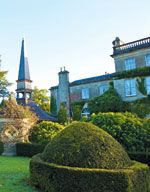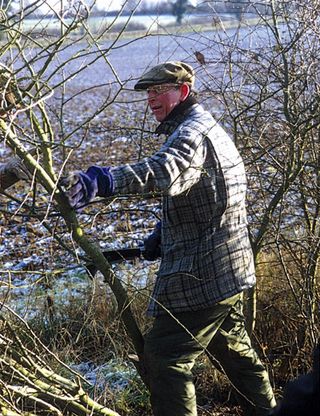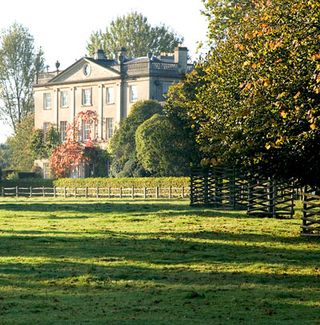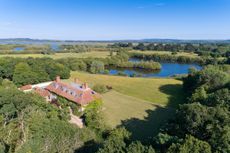The trees of Highgrove House
Country Life visits Highgrove House, where the royal passion for trees is obvious from 1,000 years of planting and pruning


Members of the British Royal family have had an intimate (and distinctly mixed) association with trees that stretches back almost 1,000 years. William I and George III both created great forests. For William, it was to protect and enhance habitat for the royal pursuit of beasts of the chase the New Forest in Hampshire and Windsor Great Park are surviving examples of this. For George III, forests such as the Forest of Dean in Gloucestershire and Alice Holt in Surrey were planted with oak as a way to protect the nation. It was planned that, once mature, their timbers would make great ships for the Royal Navy. Some trees provided singular Royal protection.
The original Boscobel oak in Shropshire hid Charles II from his pursuers after the Battle of Worcester in 1651, and almost certainly saved his life, a story that is commemorated to this day by hundreds of Royal Oak inns and pubs. History, on the other hand, has recorded that, for at least one monarch, a tree was a contributory factor in their death. In 1100, William II (William Rufus) was killed by an arrow shot by Sir Walter Tyrell and intended for a stag. It glanced off an oak and entered the king’s heart.
In more recent times, it has become the tradition for all members of the Royal family to plant trees as part of an official visit or engagement. It’s seen as a long-lasting and positive way to commemorate an occasion, and it does, of course, make a good photo opportunity for the press. Given the number of engagements members of our present Royal family undertake, it would be fascinating to know just how many Royal Trees have been planted around the country since June 1953. Yet there is one family member in particular who plants trees on his own land, too, and has been doing so for nearly 30 years The Prince of Wales.
In fact, to say that Prince Charles simply plants trees is to do him a disservice, as he is actively involved with all aspects of tree establishment and management at Highgrove House, his country home in Gloucestershire, at Birkhall in Scotland, and at Clarence House in London. Not only that, he has, over the years, become widely respected for his great understanding and knowledge of trees in the landscape, their conservation and wildlife value, and the global importance of trees in helping to offset the environmental problems that human development has created. Prince Charles acquired Highgrove, his estate near the market town of Tetbury, in 1980.

It could not be said that the grounds at that time were particularly rich, arboreally. Nevertheless, there already existed a number of characterful veteran oaks, an avenue of neglected golden yews and one magnificent cedar of Lebanon with outstretched limbs reaching towards the house. However, much of the immediate land surrounding the house was grass and rough pasture, with little development in the gardens, and the wider landscape was still reeling from the shockwaves of Dutch elm disease that had left greying skeletal remains in almost every hedgerow.
Twenty-eight years on, the transformation is quite remarkable, and shows that even with trees, quite beautiful landscapes can be created in a relatively short period of time. Those once neglected golden yews have been clipped into a collection of fascinating living sculptures ranging from coronets to helter-skelter like cones, and throughout what are now a whole series of ‘garden rooms’, the exciting and imaginative use of topiary adds all-year round structure and interest to the landscape. It’s not surprising that, given Prince Charles’ interest in trees, he has received many arboreal gifts over the years, and these are to be found carefully placed throughout his gardens, together with gifted statuary, sculpture, pots and buildings.
One particularly fine specimen is situated in the Cottage Garden, designed by Prince Charles and the late Rosemary Verey. It’s a striking, golden-leaved Indian bean-tree Catalpa bignonioides Aurea, which was a 50th birthday present from Sir Elton John. Another is a rare Manchurian ash Fraxinus mandshurica, a gift from the Dalai Lama, planted in the meadow in 1999. Occasionally, tree gifts may come in pairs or even whole collections, as happened when the Brogdale Horticultural Trust in Kent offered apple trees from the National Fruit Collection. It was an ideal opportunity for Prince Charles to help conserve some of Britain’s traditional (and, in some cases, endangered) apple varieties, and so the offer was accepted.
Sign up for the Country Life Newsletter
Exquisite houses, the beauty of Nature, and how to get the most from your life, straight to your inbox.
Today, there are two such orchards at Highgrove, producing fruit from varieties such as Ashmead’s Kernal, Caroline, Golden Knob and Devon Buckland. Highgrove also holds one of the National Council for the Conservation of Plants and Gardens (NCCPG) collections of Fagus (beech trees), once again displaying Prince Charles’ keenness to help conserve plant diversity. Beeches are very much at home on the limestone soils of the Cotswolds, and cultivars such as Fagus sylvatica Aspleniifolia, Dawyck, Pendula, Riversii, and Rohanii are thriving under Highgrove’s regime of care and maintenance, as is Fagus sylvatica Roseomarginata (syn. F. s. Purpurea Tricolor), an unusual cultivar boasting bronze-purple leaves edged with a frill of pink variegation.
Given Prince Charles’ great passion for trees, it would be surprising if an arboretum had not been included in the Highgrove landscape, and he certainly doesn’t disappoint. It lies to the east of the house, within what was once a plantation of larch trees grown for timber, and surrounds a cob-walled retreat known as The Sanctuary, bearing a Costwold stone-tiled roof. It was built in 1999 to mark the millennium, and is used by Prince Charles as a place for quiet contemplation. Work began on the arboretum in 1992, when staff from nearby Westonbirt Arboretum helped to thin the larch to allow space for the introduction of exotic and ornamental trees from around the world, and then advisedon what trees to include.

Today, Japanese maples, large leaved Himalayan rhododendrons, Chinese dawn redwoods Metasequoia glyptostroboides, American red oaks and several exotic beech are just some of the species providing all-year-round interest and in particular superb autumnal displays. They may be planted on a smaller scale than at Westonbirt, but are easily its equal with regard to vibrancy of leaf colour. Intermingled with these exotic beauties are several areas of hazel, which are regularly coppiced by Prince Charles and his staff to provide the raw material for plant supports and hurdles, which are then used in the Highgrove gardens.
Together with hedge-laying, it’s a task that Prince Charles finds particularly rewarding, which demonstrates his great interest in the practical uses of trees, as well as simply growing them for their ornamental and aesthetic value. Throughout Highgrove, there are examples of the wood from trees being used to create imaginative follies, rustic temples, sculpture and a superb Stumpery, a Victorian concept whereby stumps and roots of ancient trees are interlocked to create a primeval, Tolkien-like landscape, which is then planted up with ferns and foliage plants.
At the heart of The Stumpery is Hollyrood House, a thatched tree house where Princes William and Harry used to play as children. Close by is one of Prince Charles’ finest arboreal creations: a remarkable Southern Hemisphere garden full of tender Antipodean, South American and South African treasures, including a near forest of tree ferns Dicksonia antarctica and Cyathea australis, cabbage palms, bananas, eucalyptus and the strangely exotic umbrella pine, Sciadopitys verticillata, a native of central Honshu in Japan, where it’s becoming endangered in the wild. Although plants such as these have been grown for some time in gardens along the western fringes of Britain, where they benefit from the moist, warm winds of the Gulf Stream, it’s still surprising to see them so obviously thriving in the less-temperate climate of the Cotswolds. I mentioned that welcoming Prince Charles to Highgrove in 1980 was a magnificent Cedar of Lebanon.
Tragically, in 2005, it began to show signs of foliage discolouration, which was followed by a period of steady decline, to such an extent that, by late 2007, it was barely alive and needed to be felled. This was a moment of great sadness for Prince Charles, who had admired the tree for more than a quarter of a century. To commemorate its departure, an open-sided, shingle-roofed pavilion, designed by Mark Hoare and topped by a dramatic wooden spire, now provides the focal point to this area. Part of the value of the cedar lay in the fact that it was such an important feature in the Highgrove landscape, as it was one of comparatively few trees planted on the estate by previous generations.
Prince Charles can take heart from the fact that, owing to the great wealth of planting done under his stewardship, the arboreal legacy he eventually leaves behind will be rich indeed. It is possible for specific groups to view the Prince of Wales’ gardens at Highgrove House, although there is currently a two-year waiting list. Those groups and societies wishing to be considered for escorted tours should write to: Garden Tours Administrator, Highgrove House, Doughton, Tetbury, Gloucestershire, GL8 8TN. For more details, visit www.princeofwales.gov.uk
Country Life is unlike any other magazine: the only glossy weekly on the newsstand and the only magazine that has been guest-edited by HRH The King not once, but twice. It is a celebration of modern rural life and all its diverse joys and pleasures — that was first published in Queen Victoria's Diamond Jubilee year. Our eclectic mixture of witty and informative content — from the most up-to-date property news and commentary and a coveted glimpse inside some of the UK's best houses and gardens, to gardening, the arts and interior design, written by experts in their field — still cannot be found in print or online, anywhere else.
-
 The V&A and Burberry announce landmark Fashion Gallery makeover
The V&A and Burberry announce landmark Fashion Gallery makeoverThe V&A is renovating one of its largest and most-visited spaces — with support from British fashion house Burberry.
By Amie Elizabeth White Published
-
 A spectacular coastal estate in Dorset set on its own private peninsula
A spectacular coastal estate in Dorset set on its own private peninsulaThis 160-acre estate is part nature reserve and part country home, with a beautiful Arts-and-Crafts home at its heart.
By Arabella Youens Last updated
